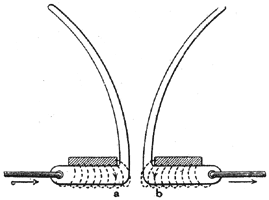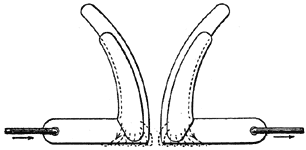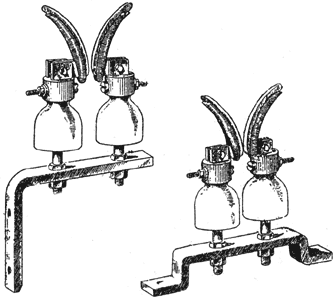[Trade Journal]
Publication: American Electrician
New York, NY, United States
vol. 14, no. 4, p. 174, col. 1-3
Lightning Arresters. — The Electrotechnische Zeitschrift contains in a recent issue an interesting article on "horn" lightning arresters, by Eugen Klein. As is doubtless well known, lightning safety devices for electrical apparatus usually
 |
| Fig. 11. — Diagram of Connections. |
consist of a spark-gap connected between earth and the apparatus to be protected, as shown in Fig. 11, and a few turns of wire placed in the connection to the apparatus itself. The atmospheric discharge, which is generally of an oscillatory character, is "choked" out of the path containing the inductive resistance and passes to earth by means of the spark-gap. If a dynamo is to be protected against atmospheric discharges, it is
 |
| Fig. 12. — Distorted Field. |
further necessary to provide tor the prompt breaking of the connection to earth formed by the spark-gap. Of the numerous instruments proposed tor this purpose, those constructed without moving parts deserve the preference. A special class of the latter consists of those known as the "horn" lightning arresters from their distinctive shape. These were first introduced by Professor Elihu Thomson, who employed an electromagnetic
 |
| Fig. 13. — Thin Horned Lightning Arrester. |
blow-out to get rid of the short-circuited arc; the latter was driven upwards along the horns, becoming longer and longer through the increasing distance between the plates and finally broke up. A simplification of the Thomson device made by Siemens & Halske eliminates the electro-magnetic blow-out entirely. The discharge plates are narrow, and are so shaped that
 |
| Fig. 14. — Modified Thomson Lightning Arrester. |
the spark-gap lies above the wires connecting the horns to the circuit. The electrodynamic action of the current in the horns on the arc then drives the latter upwards. The author found that even with the unsatisfactory form of horn shown by Fig. 14 a very energetic expulsion of the arc could be insured by casing the horns with iron, and thus producing an unsymmetrlcal distribution of the field surrounding the arc. The action of such a lightning arrester may be explained as follows: The field produced in the air by
 |
| Fig. 15. — Commercial Forms of Lightning Arresters. |
a wire carrying a current is concentric to the wire, as is well known. If, now, a piece of iron be brought in the neighborhood of the wire, the field becomes distorted somewhat, as shown in Fig. 12, and the number of lines becomes increased. They lie partly in the iron, and in attempting to shorten their path still more they exert a pull on the latter. This effect is made use of here. The magnetic attraction between the iron and the wire causes the latter to tend to approach the iron. If now the part a b, of the wire consists of an arc, this will, in consequence of its small mass, experience a powerful attraction towards the iron. Nothing will be altered if the iron be cut and opened out, and the ends of the wire a and b be provided with horn-like extensions, as shown in Fig. 13. When employing horns of the Thomson type, the effectiveness of the iron plates can be improved by means of added shoes, as shown in Fig. 14. By the addition of such shoes the shape of the horns can be altered at will. On this account the preference has been given to those forms employing large masses of metal, as these are more capable of dissipating the heat set up by the short-circuit, and are not so likely to be bent out of shape as the thin wire horns. The original Thomson form has been, therefore, retained, but with the addition of iron sheaths. Fig. 15 shows one of the forms now made.
